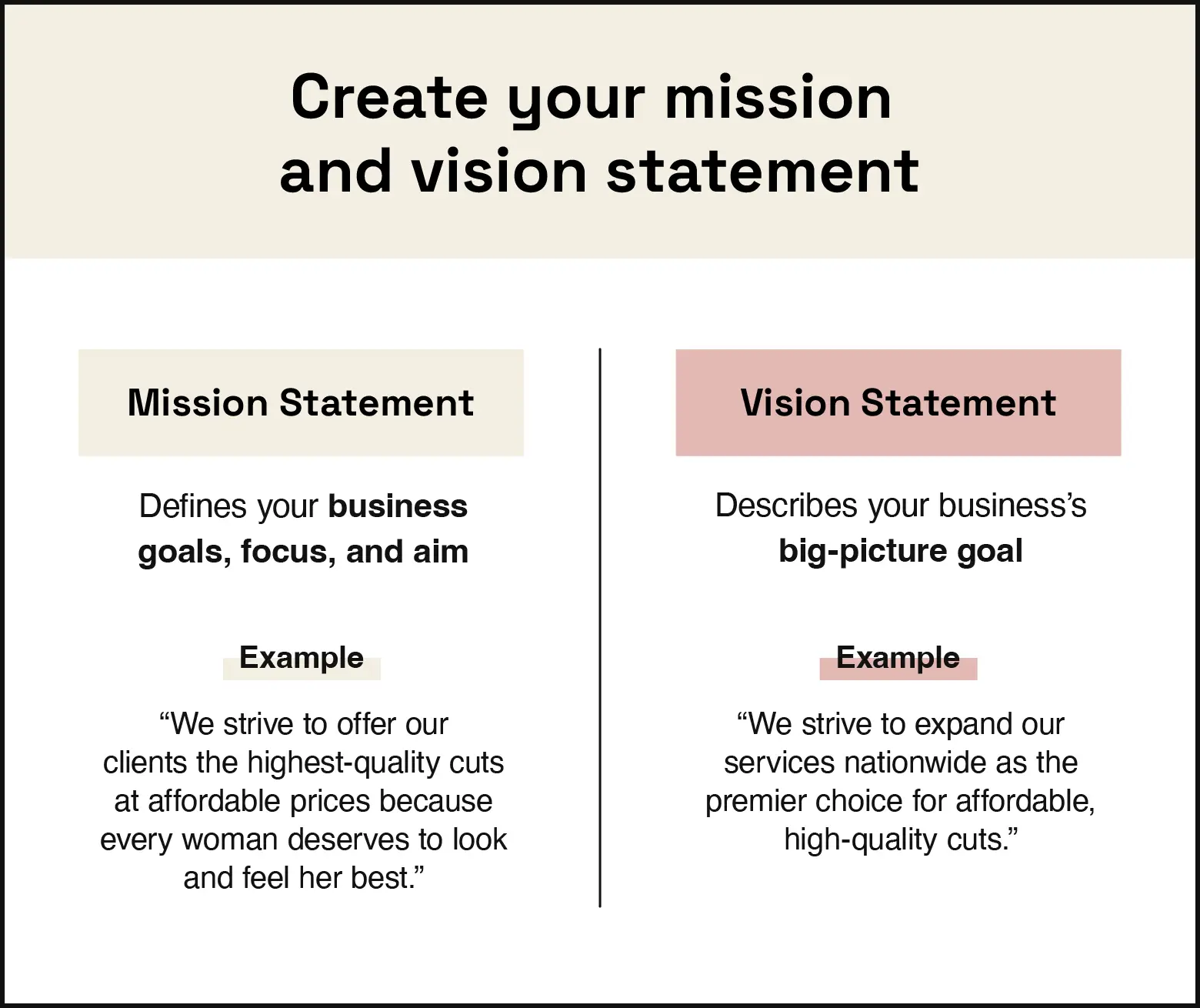Looking to open your own salon? Despite a looming recession, it’s a great time to do so — beauty industry statistics show the salon industry grew about 17 percent in 2022, and the majority of Americans claim they’re not planning to cut back on beauty spending anytime soon.
But before you start rounding up clients, you will need a thorough salon business plan to align your goals. While it may be tempting to jump in on the action as soon as possible, taking the time to plan your business properly will set you up for success in the long run. From market analyses to advertising campaigns, we’ll walk you through everything you need to know to create a winning salon business strategy.
1. Create your mission and vision statement
First things first — what are you planning to do with your new salon business? To answer this question, you’ll need to put some serious thought into your mission and vision statements. These statements articulate the purpose and goals of your salon and will guide the rest of your business plan.

Mission vs. vision statements
While mission and vision statements are often used interchangeably, there are differences between the two. It’s recommended that a new business have both statements before laying out its business plan.
A mission statement describes the short-term goals of the company — essentially defining the core purpose of the company and how it plans to achieve that purpose. Let’s break down this example of a salon’s mission statement:
Mission Statement
“We strive to offer our clients the highest-quality cuts at affordable prices because every woman deserves to look and feel her best.”
In this example, the business plans to offer high-quality cuts at affordable prices — the “what” and “how” — because they believe “every woman deserves to look and feel her best” — the “why,” or core purpose.
The mission statement serves as a roadmap to achieving your business’s vision statement.
A vision statement defines your salon’s big-picture aspirations — the driving force behind your short-term actions and goals. Here’s a vision statement the example salon above might write:
Vision Statement
“We strive to expand our services nationwide as the premier choice for affordable, high-quality cuts.”
This example clearly states the business’s future goals to help define the path toward future success.
2. Know your market
Before you open your doors, you need to know who you’re opening for (your target audience) and what salons you’re up against (your competitors). Both will provide valuable information to help you determine what your clients value most.
Recognize your target audience
Your target audience is a particular group of people who may be interested in your services. A target audience profile can be broken down into four main characteristics:
- Demographic: The main characteristics of your target market, including age, income level, gender, occupation, and education level
- Geographic: Where your audience lives, works, or travels
- Psychographic: Your target audience’s lifestyle, attitude, interests, and values
- Behavioral: What your ideal clients want, why they want it, and how they go about achieving their needs
Let’s face the facts — everyone and their mom could use a cut and color. It’s up to you to determine who to market your business to. Are you most interested in serving the most high-end clientele, or would you rather cater to college students looking to experiment with fun, trendy styles? Will the area of town you’re located in affect how you position and price your services?
Knowing your target audience will influence every stage of your business plan, so it’s essential you recognize what their needs and motivations are from the start.
Conduct a market analysis
Analyzing your salon’s target audience is just the first step in breaking down your target market. To truly get a comprehensive view of your business landscape, you’ll want to conduct a market analysis.
A market analysis is a thorough assessment of your specific market within the salon industry. In addition to defining your target market, a market analysis should include:
- Potential clients’ buying habits
- The size of your target market
- The state of the industry and industry projections
- How much your potential clients are willing to pay for your services
- Who your main competitors are
- Your competitors’ strengths and weaknesses
A thorough market analysis is essential for reducing risks, identifying emerging trends and opportunities, and projecting revenue. It’s good practice to reevaluate your findings annually and adjust your salon’s business plan accordingly. Plus, you’ll be able to factor in actual customer feedback once your doors are open.
Pro Tip
Take advantage of free market research tools like Google Trends, SurveyMonkey, and data from the Bureau of Labor Statistics and U.S. Census to aid in your market research strategy.
3. Identify your strengths, weaknesses, opportunities, and threats
With a better understanding of how you plan to position your salon within your target market, you’re ready to dive into your first SWOT analysis. A SWOT analysis is a compilation of internal and external factors that will impact your business.

Internal factors are resources and experience readily available to you — they’re categorized as either strengths or weaknesses. Examples of internal factors to include in your SWOT analysis are:
- Financial resources
- Physical resources
- Human resources
- Natural resources
- Trademarks, patents, and copyrights
Your opportunities and threats are defined by external factors, such as:
- Market trends
- Economic trends
- Funding
- Demographics
- Suppliers and partners
- Political, environmental, and economic regulations
Once you’ve completed the SWOT framework, create an innovative business strategy that will leverage your strengths and opportunities to overcome your weaknesses and threats. The SWOT analysis compels you to take a methodical and objective look at where you stand now and what you need to do to succeed.
4. Draft your salon’s executive summary
With your target market and new industry knowledge in mind, it’s time to create the most important part of your salon business plan: the executive summary.
An executive summary is a short synopsis of your overall business plan and intentions for your new salon. Don’t let its size fool you — your executive summary is the first impression business partners and investors will have of your business. While it may be brief, your executive summary must make an impact.
Pro Tip
Business strategy experts agree that an executive summary should be between 5 and 10 percent of the length of your entire business plan.
What to include in your executive summary
A solid salon executive summary will provide a ton of useful information condensed into a short, sweet, and easy-to-understand package. Try your best to tie in the following when drafting your summary:
- Strong introduction: If you want to capture your reader’s attention immediately, you’ll want to put together an introductory paragraph that not only pulls them in, but explains who you are, what you offer, and what problems you intend to solve. Keep your intro short and concise.
- Market view: Based on your market research analysis, briefly summarize the state of your target market, the needs of your target audience, and how you plan to position your salon amongst your competitors.
- Unique selling points: What will your salon bring to the table that’ll set it apart from competitors? List any unique selling points that customers and stakeholders will find valuable.
Financial expectations and forecasts: If you plan on sharing your business plan with potential investors or stakeholders, list the projected expenses and costs it’ll take to open and operate your salon, as well as what profits you expect to generate within the first six months. Explain why your salon needs financing and why investing in your business is a smart move.
5. Write your salon’s unique business description
Congratulations on completing the research portion of your salon business plan — it’s finally time to start bringing your dream salon to life!
First and foremost, you’ll need to figure out how to brand your salon. There are almost a million registered hair salons in the U.S., so how can you make yours stand out?
Start by drafting your salon’s business description — this should set the scene for what customers can expect when walking into your salon. Are you hoping to give off a funky, casual vibe? Or maybe a more elegant ambiance, champagne included? The tone of your business description should convey this, as well as:
- Services you specialize in
- Packages or perks you offer
- Unique selling points that distinguish you from other salons
With a business description in place, you can now create a company logo and tagline to complete your new brand!
6. List your products, services, and prices
Let’s get down to the nitty-gritty — what are you offering, and how much will it cost? While you may be able to do it all, some services will pay off better than others. You may be doing yourself a disservice if you purchase all the supplies for perms when your clients want blowouts.
To determine which services and products will benefit your business the most, ask yourself the following questions:
- What is my target audience interested in?
- What do I have experience in?
- What is trending?
- What are my competitors offering (or more importantly, what are they not)?
Once you have your service list set, you’ll need to calculate pricing. Striking a balance between making a stellar profit and attracting and retaining clients is one of the most difficult parts of running any business. Consider these factors when determining a fair price for your salon services:
- Similar rates in your area
- Cost and use of supplies
- Time spent on the service
- Your experience level
Pro Tip
Review and reevaluate your services and pricing at least once a year to ensure you’re charging your worth. Cost of living, supply costs, and any additional training you may have undergone warrant a price change — just be sure to notify your loyal regulars before new pricing goes into effect.
7. Lay out your salon’s operation and logistics plan
While the earlier sections of your salon’s business plan defined your goals, your operation and logistics plan will detail how you plan to meet them. Your operations plan will have two sections:
- Short-term processes: List all the tasks, employees, vendors, software, and supplies you’ll need to run your salon on a day-to-day basis.
- Long-term milestones: Describe what you hope to achieve in the future. For new businesses, this could include the date you plan to finalize your lease, your grand opening date, or the date you hope to reach your first $100,000 in sales.
Putting together your operations and logistics plan may make you realize just how much work goes into running a salon. Scheduling appointments, promoting your new business, managing payment processes, and tracking down no-shows on top of actually performing your services can get really overwhelming, really fast. Learn how StyleSeat can help you manage and grow your business so you can focus on what you do best.

8. Define your marketing and outreach strategy
No matter how much effort you put into designing your salon, acquiring top-of-the-line tools, or hiring the best stylists in your area, no one’s going to schedule an appointment at your salon if they don’t know you exist. That’s where your salon marketing and advertising strategy comes into play.
While there are literally thousands of way to bring attention to your salon, these marketing and outreach tactics are tried and true:
Build a website
Whether you’re targeting tech-savvy Gen Zers or old-school baby boomers, you’ll need to ensure your business is Google-able. Building your website should be the first step in creating your online presence. For the best customer experience, make sure to include your salon’s:
- Contact information and address
- Services and pricing
- Unique selling points and mission statement
- Customer reviews and testimonials
- Links to social media profiles
Invest in social media marketing
Harness the power of Instagram, Facebook, TikTok, Pinterest, and more with a dedicated social media marketing and influencer strategy. Sharing behind-the-scenes content, before and after photos, and happy customer reactions can make your business appear more personable and reputable. It’s also a great way to boost engagement, interact with your client base, and cultivate brand awareness.
Studies Show
44 percent of beauty salons were focused on growing their social media profiles in 2022, and 35 percent of stylists claim their growing social following was their biggest opportunity for business growth.
Establish rapport and build customer loyalty
Convincing a potential customer to give a new hairstylist a try is a lot more difficult than it seems. One way to sweeten the deal is to offer first-service discounts or lower prices the first few months to get interested clients through the door. If they’re happy with your service, they’ll likely stay — especially if you have a loyalty program in place that offers discounts and perks for regular customers!
8. Get your finances in check
If you’ve already set your prices, take a bow — the hardest part of your salon’s financing strategy is already done. However, you’ll need to take your money a step further to get a rough idea of how your business will progress on a monthly and annual basis. This is especially important if you plan on applying for a loan or seeking investors.
It may be best to put together your full financial statement three to six months after opening your salon. It should include your income statement, balance sheet, and cash flow statement so you and your stakeholders can get a better understanding of your salon’s financial health.
Income statement
Your income statement lists both your revenue sources, expenses, and net income over a given period of time. This should include:
- Revenue
- Cost of sales
- Administrative expenses
- Operating expenses
- Non-operating income and expenses
- Gains and losses
- Non-recurring items
- Net income
If you haven’t opened your salon yet, you can project future milestones with the same information.
Balance sheet
Your balance sheet provides a look at how much equity you have in your business. It consists of two parts:
- Business assets: What you own, such as cash, accounts receivable, inventory, prepaid expenses, or salon supplies
- Liabilities: What you owe, including loans, credit card balances, payroll taxes, accounts payable, and your lease
Once you’ve listed your salon’s business assets and liabilities, you can calculate your shareholder equity by subtracting the total value of your liabilities from your assets.
Cash flow statement
Your cash flow statement will help you see when cash is low, when you have a surplus, and when you might need to access funding to keep your business afloat. Your cash flow statement lists revenue and expenses similar to your income statement, but it also takes into account when revenue is collected and when expenses are paid.
Your cash flow is positive when you have more cash coming in than you have going out, and negative when the opposite is true.
Pro Tip
Using graphs to visualize your cash flow can help you forecast when you may need to adjust operations to account for negative cash flow.
10. Plan for the future
With a well-structured business plan in hand, you’re ready to take on whatever the market has in store for you — at least for the first six months. But if you want to stay on top of industry fluctuations, the newest marketing trends, or competitor announcements, consistently review your salon business plan and company goals.
Salon business plan template
Opening a new salon requires a lot of moving parts — from remodeling your space to hiring your A-team, putting together your actual business strategy can get lost in your to-dos. Download this free helpful template to streamline your business plan and keep your goals top of mind.
FAQs
The average profit margin for salons is 8.2 percent — 0.5 percent higher than the general business average of 7.7 percent. Salon owners in the U.S. can expect to make between $14,441 and $385,332, with an average salary of $74,699.
The startup cost for your salon will depend on a number of factors, including the type of salon, location, size, number of employees, and type of clientele you’re hoping to attract. Expect to spend anywhere from $10,000 to $200,000 before your grand opening.
Salons can make more money by implementing an effective marketing and advertising strategy, running promotions and contests, and reevaluating their pricing structure. Research your industry, emerging trends, and your competitors’ strategies for inspiration.
A thorough salon business plan can help you determine your short- and long-term goals, resources required, and effective strategies to drive business to your salon. Ready to hit the ground running? StyleSeat can help you manage and grow your new salon — no monthly fee required.





